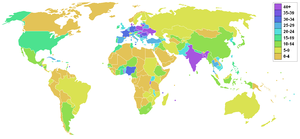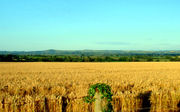Arable land
In geography, arable land (from Latin arare, to plough) is an agricultural term, meaning land that can be used for growing crops.[1] It is distinct from cultivated land and includes all land where soil and climate is suitable for agriculture, including forests and natural grasslands, and areas falling under human settlement. According to FAO report, the global land area without major soil fertility constraints is about 31.8 million square kilometers, and total potential arable land is about 41.4 million square kilometers.[2]
Although constrained by land mass and topology, the amount of arable land, both regionally and globally, fluctuates due to human and climactic factors such as irrigation, deforestation, desertification, terracing, landfill, and urban sprawl. Researchers study the impact of these changes on food production.[3][4]
The most productive portion of arable land is that from sediments left by rivers and the sea in geological times. In modern times, the rivers do not generally flood as much agricultural land, due to the demands of flood control to support intensive agriculture required of a heavily populated Earth.
Contents |
Regional Comparison
| Area | Gross potential arable area (rainfed) km2 | Percent protected | Percent built | Net potential arable area (rainfed) km2 | Utilized arable area in 1994 (including irrigation) km2 |
|---|---|---|---|---|---|
| Sub-Saharan Africa | 11,194,920 | 4.3 | 1.9 | 10,500,830 | 1,576,080 |
| North Africa & Near East | 500,170 | 4.0 | 6.4 | 448,150 | 715,800 |
| North Asia, east of Urals | 2,868,000 | 1.5 | 2.3 | 2,759,020 | 1,755,400 |
| Asia & Pacific | 8,125,510 | 4.7 | 3.9 | 7,426,720 | 4,777,060 |
| South & Central America | 10,480,710 | 5.3 | 1.2 | 9,799,460 | 1,433,520 |
| North America | 4,639,660 | 4.9 | 2.1 | 4,314,880 | 2,332,760 |
| Europe | 3,631,200 | 5.0 | 5.8 | 3,239,030 | 2,043,220 |
| World | 41,440,170 | 4.4 | 2.6 | 38,488,090 | 14,633,840 |
Data from FAO World Soil Resources Report 90.[5]
The Nile
The Nile continues to flood regularly, overspilling its banks. When the flood is over, the waters recede, leaving behind rich silt. This silt provides excellent fertilizer for crops. Even if the land is over-farmed and all the nutrients are depleted from the soil, the land renews its fertility when new deposits of silt arrive following the next flood. Flood-control projects in the region, such as levees, may increase human comfort but cause substantial adverse impact to the quantity and quality of arable land.
Non-arable land

Land which is unsuitable for arable farming usually has at least one of the following deficiencies: no source of fresh water; too hot (desert); too cold (Arctic); too rocky; too mountainous; too salty; too rainy; too snowy; too polluted; or too nutrient poor. Clouds may block the sunlight plants need for photosynthesis, reducing productivity. Plants can starve without light. Starvation and nomadism often exists on marginally arable land. Non-arable land is sometimes called wasteland, badlands, worthless or no man's land.
However, non-arable land can sometimes be converted into arable land. New arable land makes more food, and can reduce starvation. This outcome also makes a country more self-sufficient and politically independent, because food importation is reduced. Making non-arable land arable often involves digging new irrigation canals and new wells, aqueducts, desalination plants, planting trees for shade in the desert, hydroponics, fertilizer, nitrogen fertilizer, pesticides, reverse osmosis water processors, PET film insulation or other insulation against heat and cold, digging ditches and hills for protection against the wind, and greenhouses with internal light and heat for protection against the cold outside and to provide light in cloudy areas. This process is often extremely expensive.
Some examples of infertile non-arable land being turned into fertile arable land are:
- Aran Islands: These islands off the west coast of Ireland, (not to be confused with the Isle of Arran in Scotland's Firth of Clyde), were unsuitable for arable farming because they were too rocky. The people covered the islands with a shallow layer of seaweed and sand from the ocean. This made it arable. Today, crops are grown there.
- Israel: Israel's land primarily consisted of desert until the construction of desalination plants along the country's coast. The desalination plants, which remove the salt from ocean water, have created a new source of water for farming, drinking, and washing.
- Slash and burn agriculture uses nutrients in wood ash, but these expire within a few years.
- Terra preta, fertile tropical soils created by adding charcoal.
Some examples of fertile arable land being turned into infertile land are:
- Droughts like the 'dust bowl' of the Great Depression in the U.S. turned farmland into desert.
- Rainforest Deforestation: The fertile tropical forests turn into infertile desert land. For example, Madagascar's central highland plateau has become virtually totally barren (about ten percent of the country), as a result of slash-and-burn deforestation, an element of shifting cultivation practiced by many natives.
- Each year, arable land is lost to desertification and erosion from human industrial activities. Improper irrigation of farm land can wick the sodium, calcium, and magnesium from the soil and water to the surface. This process steadily concentrates salt in the root zone, decreasing productivity for crops that are not salt-tolerant.
- Urban sprawl: In the United States, 8,900 km2 (2,200,000 acres) of land was added to urban areas between 1992 and 2003.
See also
- List of environment topics
- Fertility (soil)
- Land use statistics by country
References
- ↑ Sullivan, Arthur; Steven M. Sheffrin (2003). Economics: Principles in Action. Upper Saddle River, New Jersey 07458: Pearson Prentice Hall. pp. 480. ISBN 0-13-063085-3. http://www.pearsonschool.com/index.cfm?locator=PSZ3R9&PMDbSiteId=2781&PMDbSolutionId=6724&PMDbCategoryId=&PMDbProgramId=12881&level=4.
- ↑ ftp://ftp.fao.org/agl/agll/docs/wsr.pdf
- ↑ http://www.fao.org/DOCREP/006/Y4683E/y4683e06.htm
- ↑ http://www.uncapsa.org/Flash_Detail.asp?VJournalKey=73
- ↑ ftp://ftp.fao.org/agl/agll/docs/wsr.pdf
